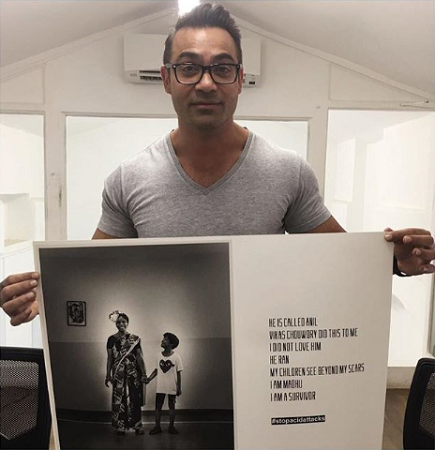 To quote an old adage, a picture speaks a thousand words. Besides capturing a moment in it’s eternity, a picture can also tell a wordless yet resounding tale at a mere glimpse of it. Visual artist Nader Bilgrami opted to convey the untold yet underlying story of several acid attack survivors through his photographs that not only gave them a voice, but also struck gold at the recent Tokyo International Foto Awards.
To quote an old adage, a picture speaks a thousand words. Besides capturing a moment in it’s eternity, a picture can also tell a wordless yet resounding tale at a mere glimpse of it. Visual artist Nader Bilgrami opted to convey the untold yet underlying story of several acid attack survivors through his photographs that not only gave them a voice, but also struck gold at the recent Tokyo International Foto Awards.
Working out of Mumbai as well as Dubai, the photographer-cum-director has come to be known for his sui generis nature of photography which communicates a story in its essence. In an exclusive interview with Animation Xpress, Bilgrami sheds light on his recent project, the milestones in his career, and what’s up next that’s keeping his hands full:
What inspired you to touch upon a subject like acid attacks?
I have a very close friend who’s sister has been a victim to an attack. We’ve always questioned as to how something so dangerous can be so easily available over the counter in India. A complete disregard by the sellers, monetary gain over the social/moral responsibilty to the damage it can cause a human..its a weapon at the end of the day.
I had come across a photo of one such survivor on the ramp in Delhi Fashion week, this was a break through moment for the survivor as people were ready to embrace her cause, but on the other end of that spectrum one other survivor had stated: “Why her and not me?”
This statement made me think of the plight of other such survivors: yes, why not them? Why can’t they too have a moment of acceptance and have their stories told, after all they are all fighting the same stigma of social unacceptance in India.
How did you approach the acid attack victims?
I approached Sapna Bhavnani who I knew was campaigning for #stopaccidattacks; its purely because of her that I got to do this. She opened the door for me, in fact, a lot of people supported me during this cause. One cannot say from the photographs but fashion designer Little Shilpa lent me her head pieces too. However, no one took credit for this as they all knew it was purely for the survivors and not a campaign for Self Social Marketing.
Imran Khatri, the producer, arranged all logistics, while Sapna, Imran and I flew to Delhi to a school where the survivors were living temporarily and we spent the day there photographing them.
Could you explain the thought process behind shading your photos black and white, as well as the one line storytelling?
I didn’t want to overshadow the survivors with colour, sometimes a photograph is often disturbed with the use of colour in it, this had to be only about them. I did not even want to highlight their scars, it was purely about the person in the photograph, you can see a few of them are shy, one at a distance and some, graceful.
The shading process is a dark room technique called “dodging & burning”. I shot on 4×5 black and white negatives to retain film grains and than to apply this technique on post. I wanted to keep it as pure as possible.
The story telling wasn’t given much though till I started to write it, I just felt comfortable writing it that way, it just seemed natural to me at that point of time.
What was your reaction when your work struck gold at the Tokyo International Foto Awards?
It felt good, the more people the cause reaches the better it is for the survivors as their own social battles.
You have now been a professional photographer for 16 years. How would you describe your journey?
Almost always unsatisfied, because there’s always a ‘more’.
What are you presently working on?
I am mostly directing films now and take up photography projects purely based on availability and the subject.
What next social issue do you intent on touching upon, if any?
I am currently working on a project for underprivileged kids, so if any brands are out there open to be part of this with me, please get in touch, even if we can give one kid a chance, its worth a shot.
